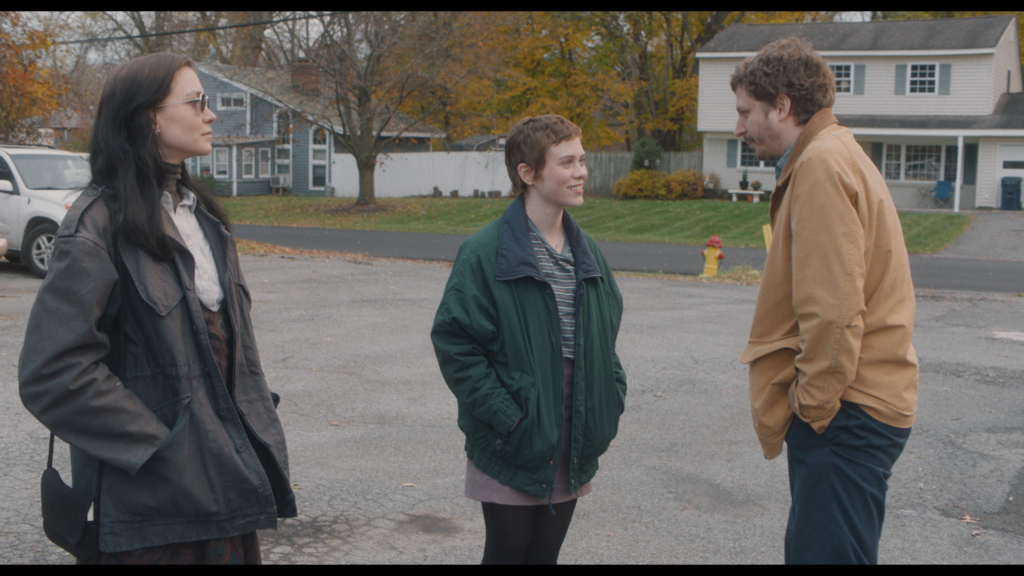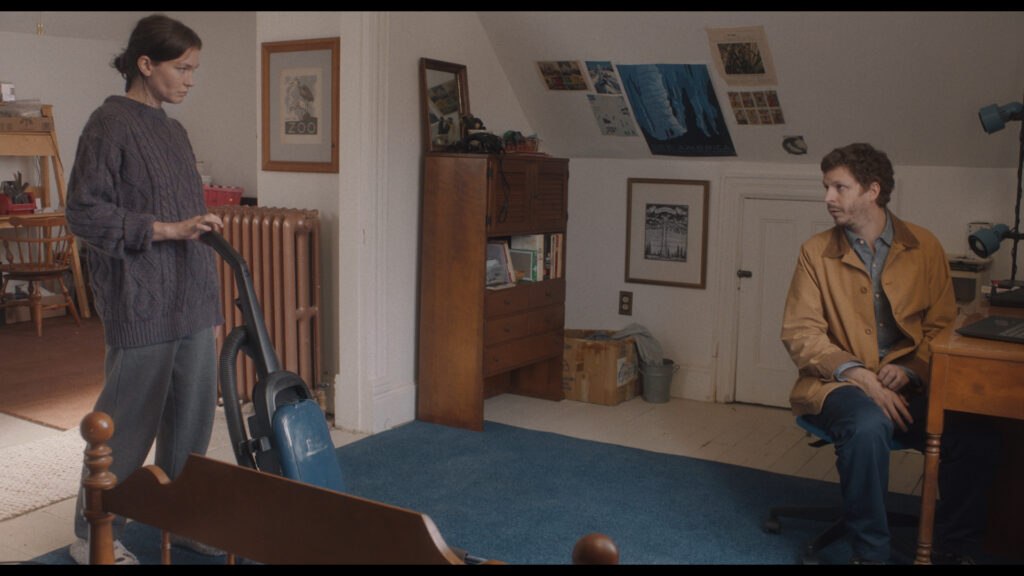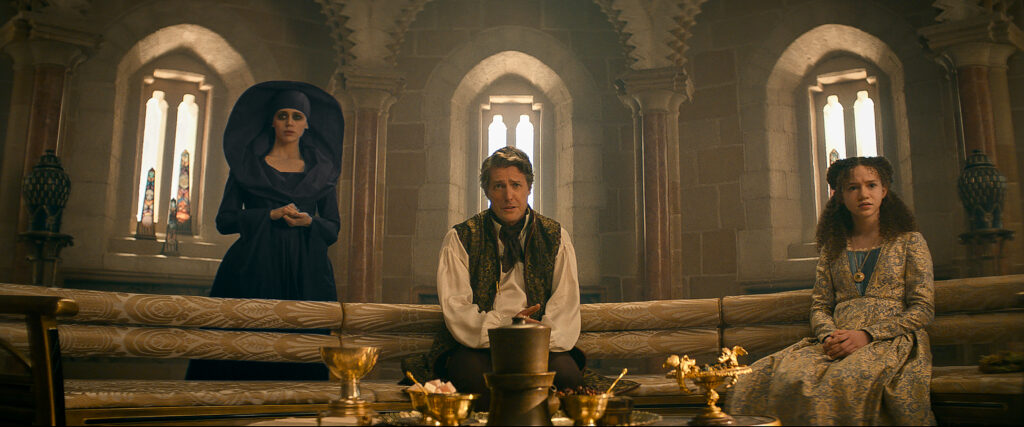July 3, 2023
by Carla Hay

Directed by Dustin Guy Defa
Culture Representation: Taking place in Hudson Valley, New York, the comedy/drama film “The Adults” features a predominantly white cast of characters (with a few African Americans and Asians) representing the working-class and middle-class.
Culture Clash: An abrasive man, who is the eldest of three siblings, visits his estranged sisters, who each have different reactions to seeing him after spending three years apart from him.
Culture Audience: “The Adults” will appeal primarily to people who are fans of star Michael Cera and movies where not much happens except family members moping, arguing, and acting out bizarre inside jokes.

Repetitive, boring and very aimless, “The Adults” is the type of movie that’s overrated by people who think that characters being obnoxious and weird in a movie should automatically deserve praise. This is “indie cred pandering” cinema at its worst. There is barely anything unique or interesting about the movie’s three main characters to justify this movie’s existence. If you’ve seen enough independent films where people act neurotic and argumentative at family reunions, then you’re not going to see anything new in “The Adults.”
Written and directed by Dustin Guy Defa, “The Adults” had its world premiere at the 2023 Berlin International Film Festival and its North American premiere at the 2023 Tribeca Festival. It’s a very slight film that doesn’t have much going for it except the name recognition of some of the stars of the movie, which was filmed on location in Hudson Valley, New York. The entire movie looks as washed-out as the lackluster tone of the film.
In the beginning of “The Adults,” Eric (played by Michael Cera), who is the eldest of three siblings, has arrived in the Hudson Valley area from Portland, Oregon, where he lives. Eric is in town to visit his two sisters, whom he hasn’t seen in three years: brittle and sarcastic Rachel (played by Hannah Gross) and bubbly and unpredictable Maggie (played by Sophia Lillis). Rachel works as a producer/editor at a radio station called WBSI. Maggie is a recent college dropout; she quit college after a year of attendance and hasn’t figured out yet what she wants to do with her life. All three siblings are unmarried and have no children.
Rachel lives in the house that she inherited after the siblings’ widowed mother died a number of years ago. Rachel is still angry with Eric that she was the sibling who had to handle all the funeral arrangements and the responsibility of paying the house’s property taxes. Meanwhile, Eric tells Rachel: “Why do you want me to feel guilty about how I’m organizing this trip when you haven’t bothered to visit me in Portland?” It’s a valid question that never really gets answered in the movie.
Maggie is just happy to see Eric and gives him a big hug when they see each other again. Eric has been so out of touch with Maggie, he didn’t even know that she dropped out of college until Rachel told him. At first, Eric had trouble contacting Maggie for this visit because, as Rachel tells him, Maggie is currently on “digital detox” where she is on a break from using any electronic devices.
During this visit, Eric spends a lot of time trying to reconnect with some of his former buddies from high school. He shows up unannounced at the house of a former school pal named Dennis (played by Wavyy Jonez), because Eric doesn’t have Dennis’ current phone number. Eric is surprised and disappointed that Dennis isn’t going to spontaneously go out to a bar with Eric, because Dennis is now a married father who doesn’t want to stay out late on this particular night. It’s the first sign in the movie that Eric is self-centered and emotionally tone-deaf.
Eric becomes fixated on getting some of his former high school buddies together to play poker, like they used to when they were schoolmates. After some dreadfully dull scenes of Eric trying to make this get-together happen, it finally does. And it just becomes an eye-rolling slog, as the conversation turns to philosophical questions that get asked and everyone in the group has to give their answers. One of the questions is, “When was the first time you realized death existed?”
Eric has a losing streak during this poker game get-together. He’s the first to admit that he’s extremely competitive. He not only wants to win back all the money that he lost, but he also wants to come out ahead by leaving with more poker game winnings than anyone else in the group. Eric even postpones his plane flight home so he can be the ultimate winner. Later, Eric gets unexpectedly humbled by his obsession to win at all costs.
Meanwhile, Rachel has been dealing with some mental-health issues such as panic attacks and depression. She’s also still reeling from a breakup from an ex-boyfriend who cheated on her, but she doesn’t want to admit to anyone how hurt she’s been by the breakup. When Eric suggests that Rachel has a bitter attitude because of this breakup, Rachel’s reaction is verbally hostile and defensive.
At the radio station where Rachel works, viewers see for the first time the family quirk that’s supposed to be a running joke in the movie. Rachel is having a discussion with a co-worker named Bobby (played by Lucas Papaelias) about what parts of a pre-recorded radio show needs to be edited out or kept in the show. All of sudden, Rachel starts talking in a cartoonish voice that sounds similar to Fozzie Bear of the Muppets. Bobby gives Rachel a puzzled look, as if he thinks she’s being too weird for him. Rachel sees that her attempt to be playful didn’t get the reaction she wanted, so she quickly stops.
Rachel, Eric and Maggie are shown using the same voice and playing guessing games as different characters, as a way to bond with each other in various parts of the movie. It’s a family inside joke that obviously goes back to their childhoods, but “The Adults” doesn’t really go into details on when these siblings started using these cartoonish voices or playing these childlike games. After a while, it just becomes very dull to watch this gimmick over and over. There’s a scene where the three siblings dance together to Men at Work’s 1983 hit “Overkill,” a song title that is an apt description for how overly repetitive “The Adults” can be with these “look at these oddball siblings” scenes.
When Eric first arrived for his visit, he gave the impression that he only wanted to stay for a few days. But then, he finds one reason after another to keep extending his visit. The problem with this poorly written part of the plot is that viewers never really know what the stakes are for Eric to keep postponing his return to Portland. Viewers know that he’s a bachelor with no kids, but what kind of life does he have in Portland that he’s putting on hold to stay in New York? The movie never answers that question.
And therein lies much of the flimsy foundation of “The Adults,” which relentlessly pushes Eric to be the center of the siblings’ conflicts but never really shows who he is except being an egotistical jerk with very little self-awareness. It’s an over-used and tiresome cliché (especially in these types of independent dramedies) to elevate this type of repugnant character as being worthy of admiration or interest, when Eric is neither smart, funny, nor charismatic enough to justify what is essentially a movie about what he decides to do with his visit.
If this is the type of dull egomaniac you want to waste your time watching in a movie, then “The Adults” is for you. Lillis and Gross give better performances than Cera, but their characters of Maggie and Rachel still come across as kind of hollow. If you’d rather watch a movie with more substance, then there are much better options in the large number of films about estranged family members having an awkward and tension-filled reunion.
Variance Flms will release “The Adults” in select U.S. cinemas on August 18, 2023.




